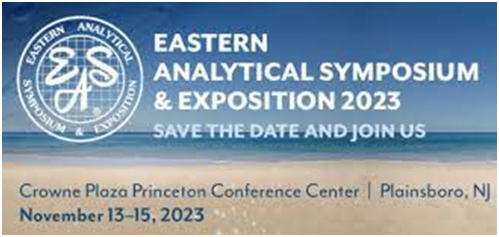By Molnár-Institute for…
MOLNÁR-INSTITUTE to address HPLC column selection issues at EAS 2023
Berlin: – Molnár-Institute for Applied Chromatography (Molnár) is returning to the Eastern Analytical Symposium (EAS) at Plainsboro, New Jersey, USA, as an exhibitor and contributor to the scientific program.
As an exhibitor at the Symposium, Molnár-Institute’s customary stand at Booth L3 at the Crowne Plaza Princeton Conference Center will showcase latest developments of its DryLab®4 software modelling and analytical platform that is revolutionizing the world of high-performance liquid chromatography (HPLC).
Modeling separation systems
Molnár-Institute Senior Scientist Arnold Zöldhegyi will address the conference on the use of 2- and 3-dimensional modelled analytical design spaces (DSs) of separation systems to alleviate the burden of alternative column selection by identifying common separation areas of multiple stationary phases.
Zöldhegyi’s presentation ‘First-Principle-Based Investigation of Column Selectivities – Using Multidimensional Analytical Design Space Models as Tools to Find Equivalent Working Ranges Across Various Stationary Phases’ will form the final contribution (15:40-16:00 hrs.) to the Conference session on Analytical Advancements Driving Pharmaceutical Excellence on the afternoon of the final day (Wednesday, November 15).
His oral presentation will provide highlights of a research study carried out in partnership with the Institute’s founder Dr. Imre Molnár and industry application expert, Dr. Róbert Kormány.
Underlying paradox of choice
The standard workflow in in high-pressure liquid chromatography (HPLC) method development is based on selecting stationary phases with ideally distinct “orthogonal” selectivities to detect unknown impurities in the pharmaceutical sample. At later stages, however, it is essential to identify backup/replacement columns with identical or near similar selectivities to avoid delays caused by problems in replacing columns with substitute stationary phases. While various vendor recommendations, databases, regulatory guides and column testing protocols can help in the search, they are all limited in focusing mainly on the column’s contribution to selectivity, overlooking other influential factors such as complex interdependences between column, sample and applied method conditions. Due to the burgeoning number of stationary phases that are available on the market, the process to find suitable columns often means a tedious process, Established industry standards have now been supplemented by new stationary phases incorporating leading-edge technologies while phases are being retired making use of ‘tried and tested’ methods more problematic. This can result in a “paradox of choice” situation in terms of appropriate stationary phase selection made even more acute by other economic factors (cost and market availability).
Benefitting from model-provided systematic understanding
The team set out to use modern modelling tools to build unique design spaces around the tested stationary phases. The main advantage of such a chromatography-based modeling approach is that it equally aligns all relevant system components—stationary-, mobile phase, instrument and sample contributions—to accurately describe the underlying interactions within the selected separation system. Consequently, newest analytical chapters of ICH (Q12 and Q14, Q2(R2) drafts) urge industry practitioners to follow similar, “enhanced” modeling approaches in systematic analytical procedure development.
The team revisited earlier work (see Resources) in using DryLab® DS-modeling software to build 3-D separation models of amlodipine and its related impurities to compare the measured performances of columns in terms of separation and robustness. Based on just 12 input experiments per column, the study was able to quantify impact of all chromatographically relevant method parameters, including gradient, column temperature, pH of mobile phase, etc., to analyze UHPLC-columns.
Zöldhegyi will share some of the surprising results encountered, including equivalences between DSs of substantially different columns and, conversely, unexpected differences between selected stationary phases, despite nominally similar column data.
While traditional approaches are regarded as limited in identifying replacement columns, the team found its advanced in-silico modeling options allowed it to allocate optimum setpoints of each separation units as well as accommodating single and even inter-column Method Operable Design Regions (MODRs) that guarantee meeting analytical performance goals in selecting columns even in case of prospective, life-cycle changes.
About MOLNÁR-INSTITUTE
Founded in 1981, Molnár-Institute develops DryLab®4, a software for UHPLC modelling for a world-wide market. Its powerful modules gradient editor, peak tracking, automation, robustness and Design Space Comparison allow for the most sophisticated method development as required across modern pharma industries. Analytical scientists use DryLab®4 to understand chromatographic interactions, to reduce analysis time, to increase robustness, and to conform to Analytical Quality by Design (AQbD) principles, according to the recently published ICH Q14 regulatory framework.
The Molnár-Institute is a registered partner of the US-FDA, CDC and many other regulatory bodies. DryLab®4 pioneered AQbD long before regulatory agencies across the world encouraged such submissions. Widely implemented by thought leaders, the software contributes substantially to the paradigm shift towards a science and risk driven perspective on HPLC Quality Control and Assurance.
Further information at: http://www.molnar-institute.com/
About EAS 2023
The Eastern Analytical Symposium and Exposition (EAS) is held each year to provide professional scientists and students working in the Eastern USA with continuing education in the analytical and allied sciences through the presentation of symposia of papers, workshops, and short courses.
For more than 50 years, the EAS Technical Program has provided cutting-edge information for the analyst with research presentations on practical and novel technologies. The symposium now typically contains over 450 papers on a wide variety of subjects, from pharmaceutical analysis to art conservation, emphasizing practical applications of a wide range technologies including Liquid chromatography, Raman spectroscopy, microscopy, and sensors in solving real-life problems,
The 2023 EAS Symposium will be a three-day event, opening November 13 at the Crowne Plaza Princeton Conference Center in Plainsboro, NJ. The 2023 conference will be themed ‘Better Life with Analytical Chemistry’, reflecting the ever-expanding array of advanced technologies available to today’s scientists. The conference will include technical sessions, short courses, special lectures, workshops and student seminars, as well as a co-located exhibition of analytical science apparatus and supplies.
The event is organised by EAS with further information available at: https://eas.org
Resources
Click on Exploring better column selectivity choices in ultra-high performance liquid chromatography using Quality by Design principles for detail of related study



















